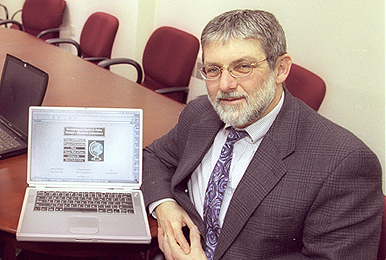E-portfolios
An online breakthrough for teaching and learning

Every university student has faced it—the request to summarize what he or she learned in a particular course or, worse yet, over an entire academic career. Whether posed by an uncle at a holiday gathering or by a job interviewer, it can be a stomach-dropping question. But now, thanks to a new Web-based tool called e-portfolios, instead of fumbling for vague answers, students at the Boston University School of Education (SED) can calmly direct their interrogator to the nearest computer.
Last fall, freshman students, faculty, and staff at SED began using e-portfolio software, part of the Open Source Portfolio Initiative (OSPI), developed by a collaboration of several universities in 2003. Individuals with an e-portfolio account each have an electronic filing cabinet, which only they can access and into which they can upload papers, or lesson plans, or PowerPoint presentations, or any other work they produce in digital form.
They can then designate any number of these items to appear in separate Web templates, ranging from profiles to resumes to specific project working groups. The separate e-portfolio templates can either be open to the public or accessible to only a select few.
“This is what I call the iceberg with a thousand faces,” says David Whittier, an SED assistant professor and coordinator of the Program in Educational Media & Technology. The hidden electronic repository is the iceberg, beneath the surface, and the faces could be anything from an expansive and interactive faculty profile to a course Web site where aspiring history teachers post multimedia course materials. Teachers can then exchange comments, suggestions, and reflections on what worked and what didn’t in the classroom.
About 90 percent of freshman registered for an e-portfolio account last year, says Whittier, and about one-third of SED faculty have created an e-portfolio profile. Whittier is currently fine-tuning course-specific e-portfolio templates for use in the fall, such as one for early childhood education and another for history and social-science teacher prep courses.
“What I see happening with this as we go forward is that students can have discussion groups based on issues of importance to them,” says Whittier. “They can post course work or PowerPoint curriculum materials, use them in a student teaching experience, and then post a reflection on that and continue the discussion.”
In addition to SED, the BU School of Management is also starting to work with e-portfolios, and Whittier hopes other schools and colleges at BU will follow. Despite their broad utility, e-portfolios have special appeal for schools of education because a portfolio-based student assessment can supplement standardized tests.
“A lot of teachers would say that using standardized tests is not the best way of evaluating student performance,” says Whittier. “With a portfolio you can look at a much wider range of projects over time to see growth and development, rather than the snapshot that you get from a test.”
Trent Batson, the director of Information & Technology Services at the University of Rhode Island and an OSPI board member, echoes this sentiment. “This is a way of using Web-accessible databases to track lifelong learning and even better define what learning is,” says Batson, an organizer of the New England ePortfolio Project, a regional alliance of universities, including BU, MIT, Brown, Tufts, and Northeastern, that promotes the technology. “Some people are really good at taking tests, but for a lot of students it doesn’t really reflect what their abilities are.”
Like any new technology, some will adopt it much faster than others, admits Whittier. Many of e-portfolio’s capabilities are already available, albeit scattered, in older technologies such as personal Web pages, discussion boards, and course management software. Nevertheless, Whittier believes that the versatility of e-portfolios will make them “more and more the currency of teaching and learning.”
“When we start with our freshmen, they pick up on this stuff right away; they’ll be classroom teachers in a few years, and some of them may go on to be faculty members at schools of education down the road,” he adds. “It’s an evolution, not a revolution.”